Retrospective Risk Management Plan for Fukushima Plant Incident
VerifiedAdded on 2020/02/24
|32
|7268
|118
Report
AI Summary
This report provides a retrospective risk management plan for the Fukushima Daiichi nuclear plant incident. It begins with an executive summary, followed by an introduction that details the project's scope, objectives, and the information related to the plant. The report discusses communication and consultation plans, stakeholder analysis, and the establishment of internal and external contexts. It delves into risk assessment processes, including identification, analysis, and evaluation, alongside risk treatment options and effective strategies. The report concludes with a discussion of risk monitoring and closure processes, referencing key documents and appendices that include risk identification checklists, risk registers, assessment matrices, treatment tables, and FMEA analysis. The report emphasizes the importance of communication, stakeholder management, and proactive risk mitigation strategies in preventing future nuclear disasters.
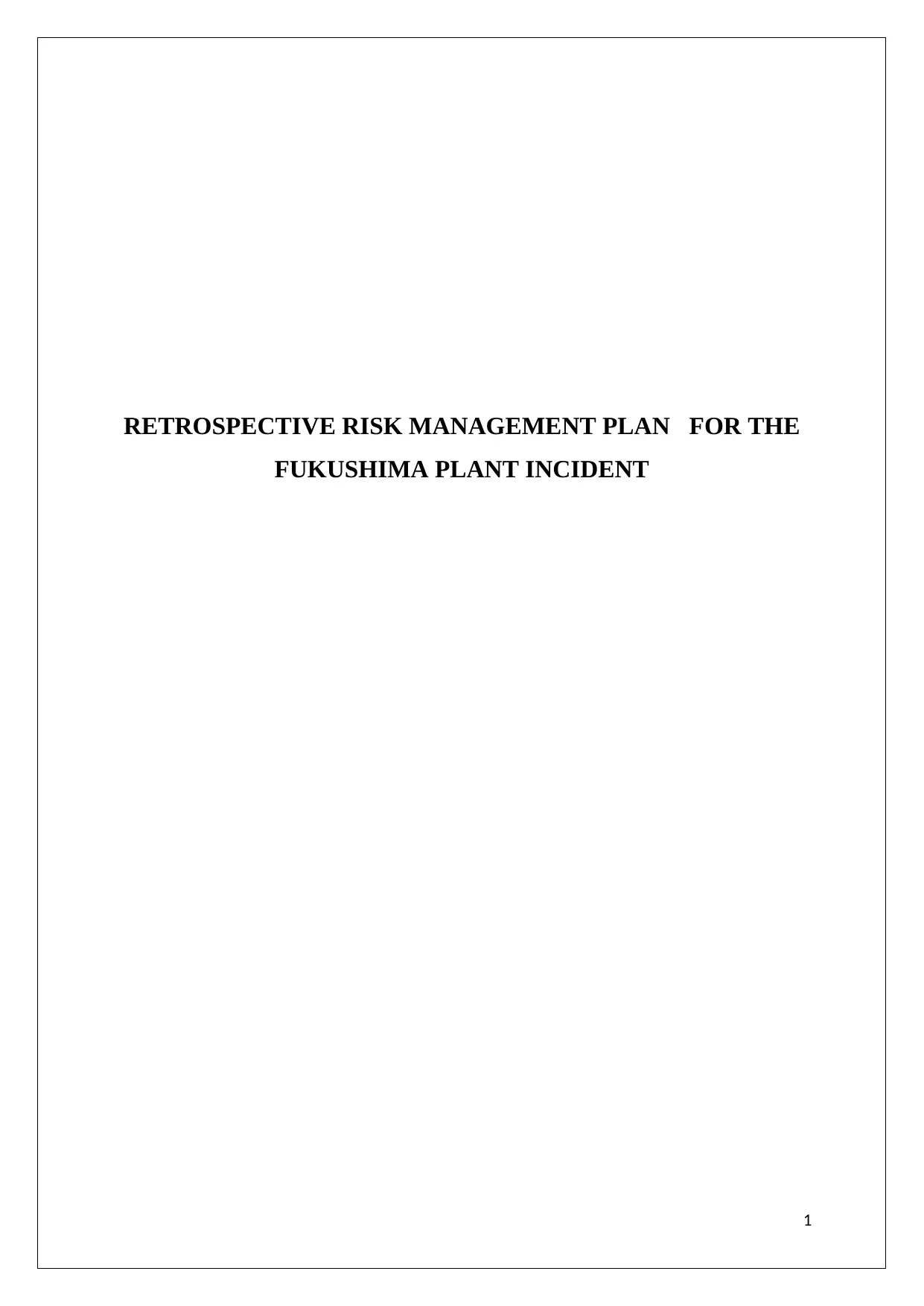
RETROSPECTIVE RISK MANAGEMENT PLAN FOR THE
FUKUSHIMA PLANT INCIDENT
1
FUKUSHIMA PLANT INCIDENT
1
Paraphrase This Document
Need a fresh take? Get an instant paraphrase of this document with our AI Paraphraser
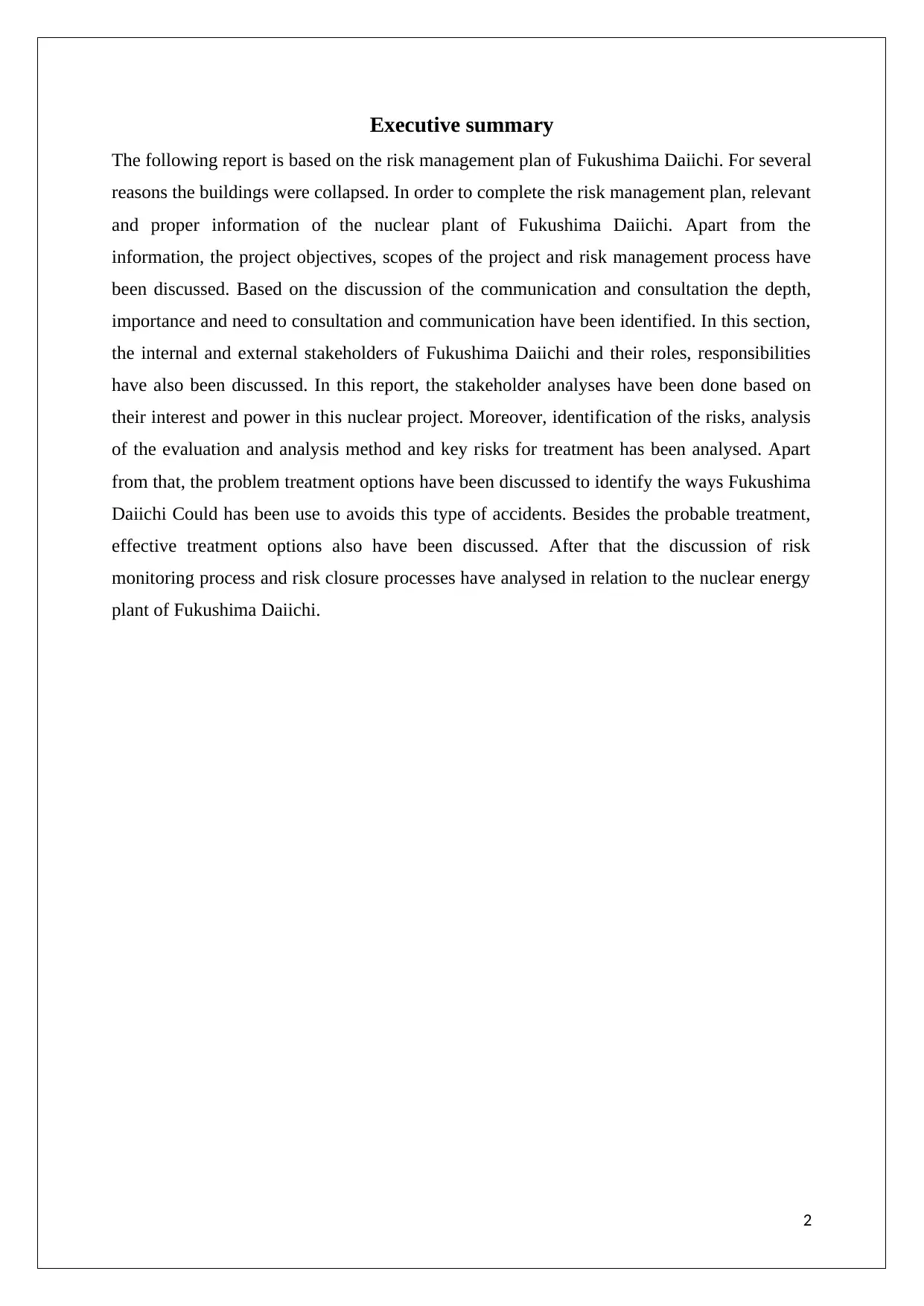
Executive summary
The following report is based on the risk management plan of Fukushima Daiichi. For several
reasons the buildings were collapsed. In order to complete the risk management plan, relevant
and proper information of the nuclear plant of Fukushima Daiichi. Apart from the
information, the project objectives, scopes of the project and risk management process have
been discussed. Based on the discussion of the communication and consultation the depth,
importance and need to consultation and communication have been identified. In this section,
the internal and external stakeholders of Fukushima Daiichi and their roles, responsibilities
have also been discussed. In this report, the stakeholder analyses have been done based on
their interest and power in this nuclear project. Moreover, identification of the risks, analysis
of the evaluation and analysis method and key risks for treatment has been analysed. Apart
from that, the problem treatment options have been discussed to identify the ways Fukushima
Daiichi Could has been use to avoids this type of accidents. Besides the probable treatment,
effective treatment options also have been discussed. After that the discussion of risk
monitoring process and risk closure processes have analysed in relation to the nuclear energy
plant of Fukushima Daiichi.
2
The following report is based on the risk management plan of Fukushima Daiichi. For several
reasons the buildings were collapsed. In order to complete the risk management plan, relevant
and proper information of the nuclear plant of Fukushima Daiichi. Apart from the
information, the project objectives, scopes of the project and risk management process have
been discussed. Based on the discussion of the communication and consultation the depth,
importance and need to consultation and communication have been identified. In this section,
the internal and external stakeholders of Fukushima Daiichi and their roles, responsibilities
have also been discussed. In this report, the stakeholder analyses have been done based on
their interest and power in this nuclear project. Moreover, identification of the risks, analysis
of the evaluation and analysis method and key risks for treatment has been analysed. Apart
from that, the problem treatment options have been discussed to identify the ways Fukushima
Daiichi Could has been use to avoids this type of accidents. Besides the probable treatment,
effective treatment options also have been discussed. After that the discussion of risk
monitoring process and risk closure processes have analysed in relation to the nuclear energy
plant of Fukushima Daiichi.
2
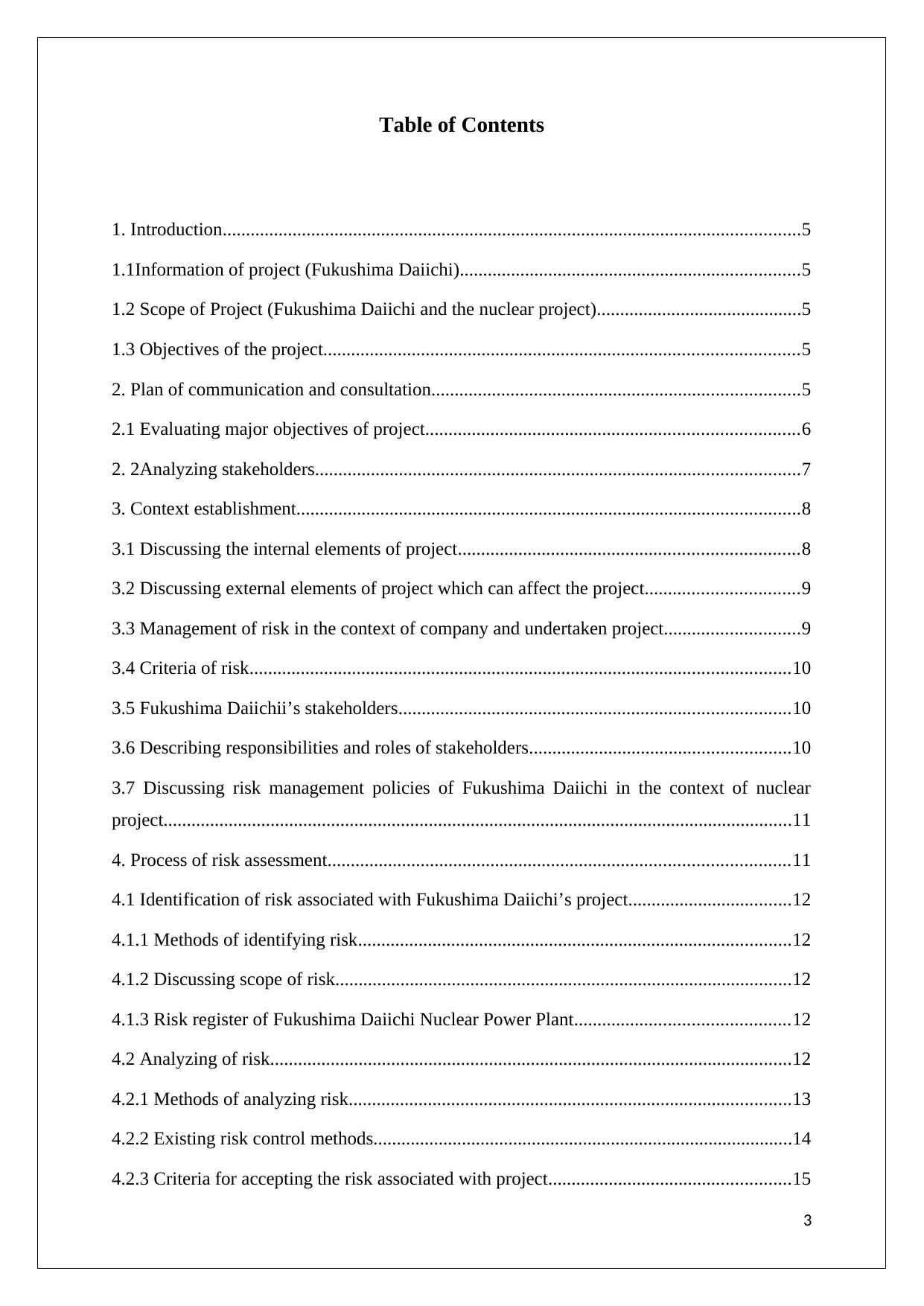
Table of Contents
1. Introduction............................................................................................................................5
1.1Information of project (Fukushima Daiichi).........................................................................5
1.2 Scope of Project (Fukushima Daiichi and the nuclear project)............................................5
1.3 Objectives of the project......................................................................................................5
2. Plan of communication and consultation...............................................................................5
2.1 Evaluating major objectives of project................................................................................6
2. 2Analyzing stakeholders........................................................................................................7
3. Context establishment............................................................................................................8
3.1 Discussing the internal elements of project.........................................................................8
3.2 Discussing external elements of project which can affect the project.................................9
3.3 Management of risk in the context of company and undertaken project.............................9
3.4 Criteria of risk....................................................................................................................10
3.5 Fukushima Daiichii’s stakeholders....................................................................................10
3.6 Describing responsibilities and roles of stakeholders........................................................10
3.7 Discussing risk management policies of Fukushima Daiichi in the context of nuclear
project.......................................................................................................................................11
4. Process of risk assessment...................................................................................................11
4.1 Identification of risk associated with Fukushima Daiichi’s project...................................12
4.1.1 Methods of identifying risk.............................................................................................12
4.1.2 Discussing scope of risk..................................................................................................12
4.1.3 Risk register of Fukushima Daiichi Nuclear Power Plant..............................................12
4.2 Analyzing of risk................................................................................................................12
4.2.1 Methods of analyzing risk...............................................................................................13
4.2.2 Existing risk control methods..........................................................................................14
4.2.3 Criteria for accepting the risk associated with project....................................................15
3
1. Introduction............................................................................................................................5
1.1Information of project (Fukushima Daiichi).........................................................................5
1.2 Scope of Project (Fukushima Daiichi and the nuclear project)............................................5
1.3 Objectives of the project......................................................................................................5
2. Plan of communication and consultation...............................................................................5
2.1 Evaluating major objectives of project................................................................................6
2. 2Analyzing stakeholders........................................................................................................7
3. Context establishment............................................................................................................8
3.1 Discussing the internal elements of project.........................................................................8
3.2 Discussing external elements of project which can affect the project.................................9
3.3 Management of risk in the context of company and undertaken project.............................9
3.4 Criteria of risk....................................................................................................................10
3.5 Fukushima Daiichii’s stakeholders....................................................................................10
3.6 Describing responsibilities and roles of stakeholders........................................................10
3.7 Discussing risk management policies of Fukushima Daiichi in the context of nuclear
project.......................................................................................................................................11
4. Process of risk assessment...................................................................................................11
4.1 Identification of risk associated with Fukushima Daiichi’s project...................................12
4.1.1 Methods of identifying risk.............................................................................................12
4.1.2 Discussing scope of risk..................................................................................................12
4.1.3 Risk register of Fukushima Daiichi Nuclear Power Plant..............................................12
4.2 Analyzing of risk................................................................................................................12
4.2.1 Methods of analyzing risk...............................................................................................13
4.2.2 Existing risk control methods..........................................................................................14
4.2.3 Criteria for accepting the risk associated with project....................................................15
3
⊘ This is a preview!⊘
Do you want full access?
Subscribe today to unlock all pages.

Trusted by 1+ million students worldwide
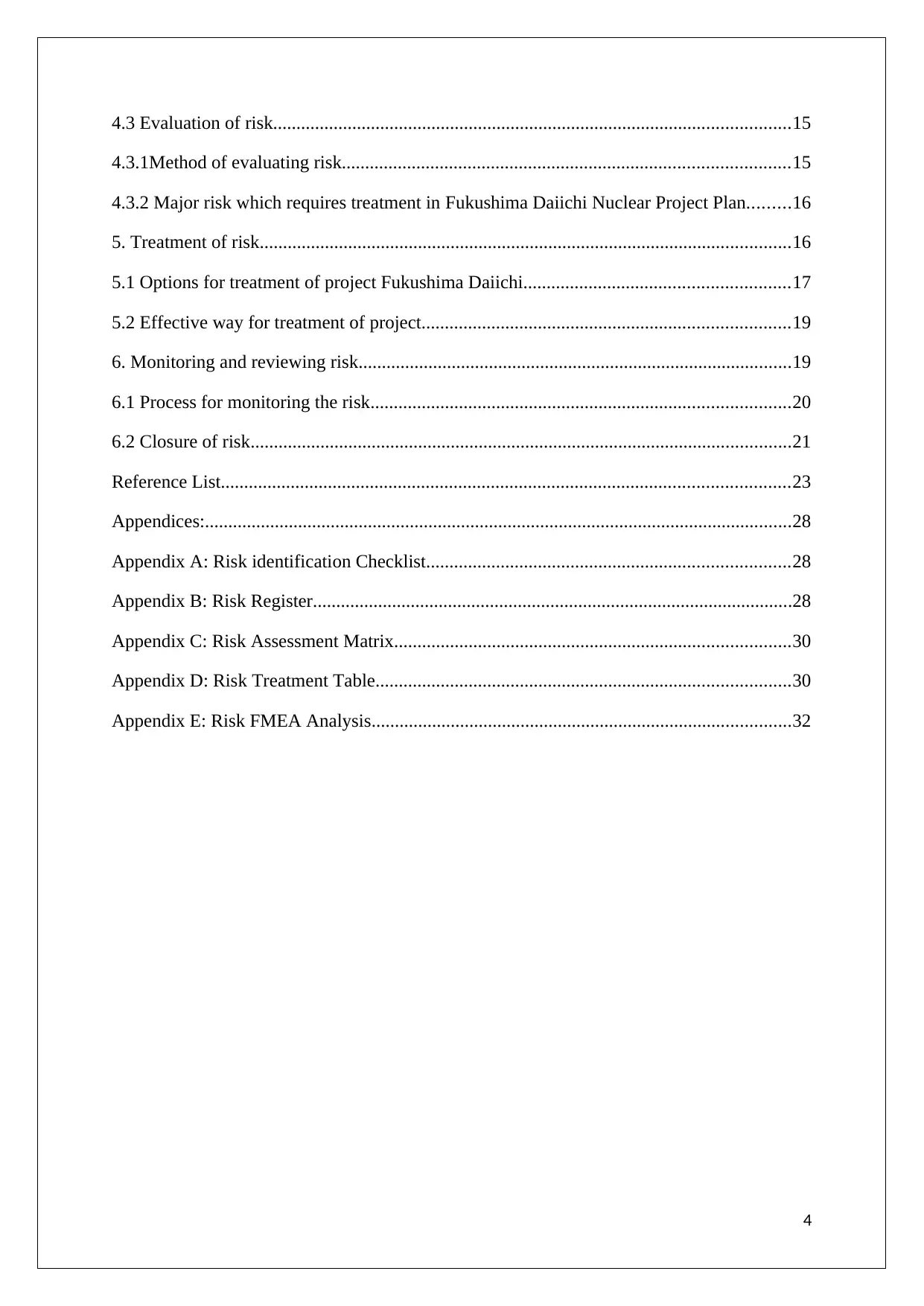
4.3 Evaluation of risk...............................................................................................................15
4.3.1Method of evaluating risk................................................................................................15
4.3.2 Major risk which requires treatment in Fukushima Daiichi Nuclear Project Plan.........16
5. Treatment of risk..................................................................................................................16
5.1 Options for treatment of project Fukushima Daiichi.........................................................17
5.2 Effective way for treatment of project...............................................................................19
6. Monitoring and reviewing risk.............................................................................................19
6.1 Process for monitoring the risk..........................................................................................20
6.2 Closure of risk....................................................................................................................21
Reference List..........................................................................................................................23
Appendices:..............................................................................................................................28
Appendix A: Risk identification Checklist..............................................................................28
Appendix B: Risk Register.......................................................................................................28
Appendix C: Risk Assessment Matrix.....................................................................................30
Appendix D: Risk Treatment Table.........................................................................................30
Appendix E: Risk FMEA Analysis..........................................................................................32
4
4.3.1Method of evaluating risk................................................................................................15
4.3.2 Major risk which requires treatment in Fukushima Daiichi Nuclear Project Plan.........16
5. Treatment of risk..................................................................................................................16
5.1 Options for treatment of project Fukushima Daiichi.........................................................17
5.2 Effective way for treatment of project...............................................................................19
6. Monitoring and reviewing risk.............................................................................................19
6.1 Process for monitoring the risk..........................................................................................20
6.2 Closure of risk....................................................................................................................21
Reference List..........................................................................................................................23
Appendices:..............................................................................................................................28
Appendix A: Risk identification Checklist..............................................................................28
Appendix B: Risk Register.......................................................................................................28
Appendix C: Risk Assessment Matrix.....................................................................................30
Appendix D: Risk Treatment Table.........................................................................................30
Appendix E: Risk FMEA Analysis..........................................................................................32
4
Paraphrase This Document
Need a fresh take? Get an instant paraphrase of this document with our AI Paraphraser
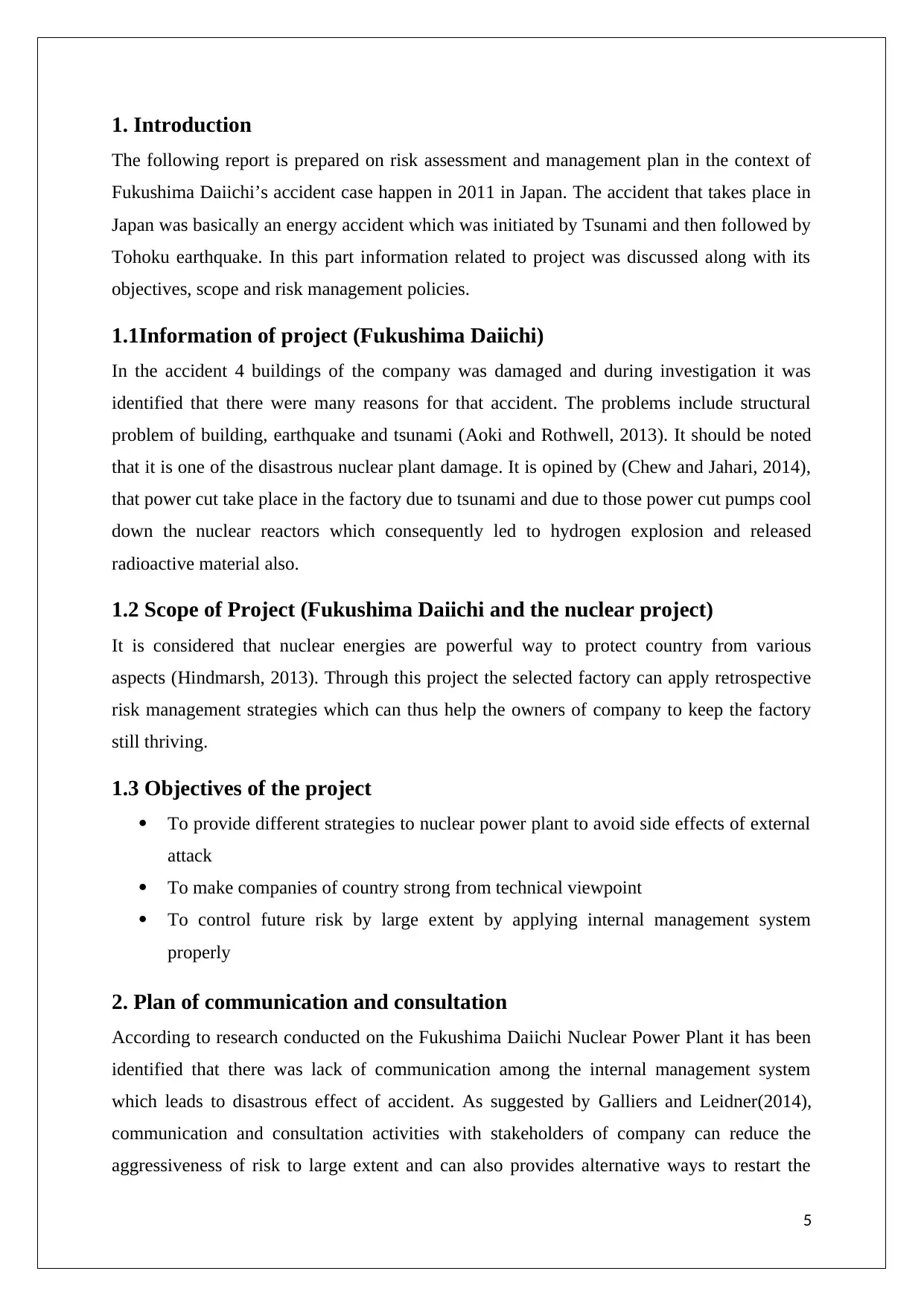
1. Introduction
The following report is prepared on risk assessment and management plan in the context of
Fukushima Daiichi’s accident case happen in 2011 in Japan. The accident that takes place in
Japan was basically an energy accident which was initiated by Tsunami and then followed by
Tohoku earthquake. In this part information related to project was discussed along with its
objectives, scope and risk management policies.
1.1Information of project (Fukushima Daiichi)
In the accident 4 buildings of the company was damaged and during investigation it was
identified that there were many reasons for that accident. The problems include structural
problem of building, earthquake and tsunami (Aoki and Rothwell, 2013). It should be noted
that it is one of the disastrous nuclear plant damage. It is opined by (Chew and Jahari, 2014),
that power cut take place in the factory due to tsunami and due to those power cut pumps cool
down the nuclear reactors which consequently led to hydrogen explosion and released
radioactive material also.
1.2 Scope of Project (Fukushima Daiichi and the nuclear project)
It is considered that nuclear energies are powerful way to protect country from various
aspects (Hindmarsh, 2013). Through this project the selected factory can apply retrospective
risk management strategies which can thus help the owners of company to keep the factory
still thriving.
1.3 Objectives of the project
To provide different strategies to nuclear power plant to avoid side effects of external
attack
To make companies of country strong from technical viewpoint
To control future risk by large extent by applying internal management system
properly
2. Plan of communication and consultation
According to research conducted on the Fukushima Daiichi Nuclear Power Plant it has been
identified that there was lack of communication among the internal management system
which leads to disastrous effect of accident. As suggested by Galliers and Leidner(2014),
communication and consultation activities with stakeholders of company can reduce the
aggressiveness of risk to large extent and can also provides alternative ways to restart the
5
The following report is prepared on risk assessment and management plan in the context of
Fukushima Daiichi’s accident case happen in 2011 in Japan. The accident that takes place in
Japan was basically an energy accident which was initiated by Tsunami and then followed by
Tohoku earthquake. In this part information related to project was discussed along with its
objectives, scope and risk management policies.
1.1Information of project (Fukushima Daiichi)
In the accident 4 buildings of the company was damaged and during investigation it was
identified that there were many reasons for that accident. The problems include structural
problem of building, earthquake and tsunami (Aoki and Rothwell, 2013). It should be noted
that it is one of the disastrous nuclear plant damage. It is opined by (Chew and Jahari, 2014),
that power cut take place in the factory due to tsunami and due to those power cut pumps cool
down the nuclear reactors which consequently led to hydrogen explosion and released
radioactive material also.
1.2 Scope of Project (Fukushima Daiichi and the nuclear project)
It is considered that nuclear energies are powerful way to protect country from various
aspects (Hindmarsh, 2013). Through this project the selected factory can apply retrospective
risk management strategies which can thus help the owners of company to keep the factory
still thriving.
1.3 Objectives of the project
To provide different strategies to nuclear power plant to avoid side effects of external
attack
To make companies of country strong from technical viewpoint
To control future risk by large extent by applying internal management system
properly
2. Plan of communication and consultation
According to research conducted on the Fukushima Daiichi Nuclear Power Plant it has been
identified that there was lack of communication among the internal management system
which leads to disastrous effect of accident. As suggested by Galliers and Leidner(2014),
communication and consultation activities with stakeholders of company can reduce the
aggressiveness of risk to large extent and can also provides alternative ways to restart the
5
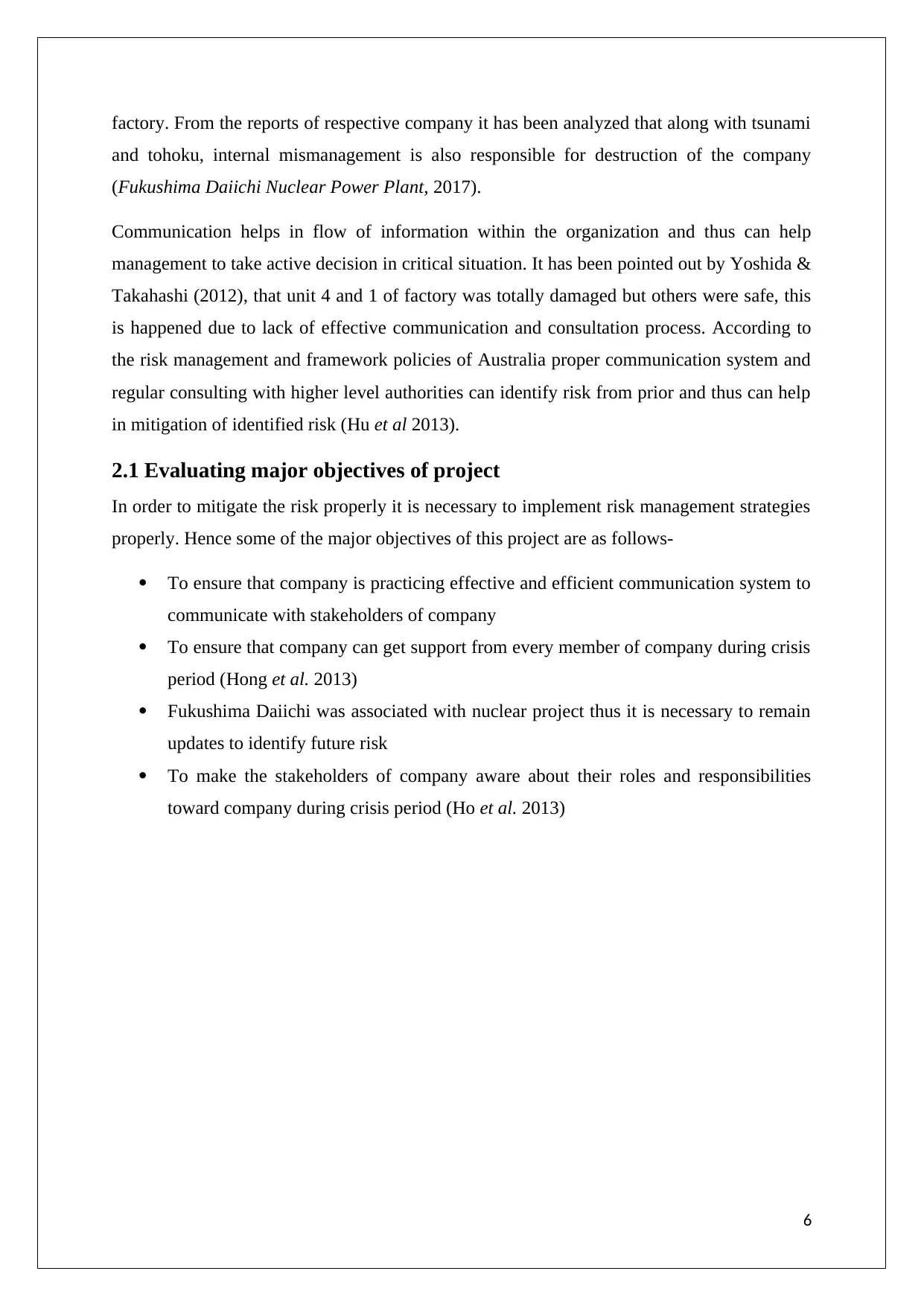
factory. From the reports of respective company it has been analyzed that along with tsunami
and tohoku, internal mismanagement is also responsible for destruction of the company
(Fukushima Daiichi Nuclear Power Plant, 2017).
Communication helps in flow of information within the organization and thus can help
management to take active decision in critical situation. It has been pointed out by Yoshida &
Takahashi (2012), that unit 4 and 1 of factory was totally damaged but others were safe, this
is happened due to lack of effective communication and consultation process. According to
the risk management and framework policies of Australia proper communication system and
regular consulting with higher level authorities can identify risk from prior and thus can help
in mitigation of identified risk (Hu et al 2013).
2.1 Evaluating major objectives of project
In order to mitigate the risk properly it is necessary to implement risk management strategies
properly. Hence some of the major objectives of this project are as follows-
To ensure that company is practicing effective and efficient communication system to
communicate with stakeholders of company
To ensure that company can get support from every member of company during crisis
period (Hong et al. 2013)
Fukushima Daiichi was associated with nuclear project thus it is necessary to remain
updates to identify future risk
To make the stakeholders of company aware about their roles and responsibilities
toward company during crisis period (Ho et al. 2013)
6
and tohoku, internal mismanagement is also responsible for destruction of the company
(Fukushima Daiichi Nuclear Power Plant, 2017).
Communication helps in flow of information within the organization and thus can help
management to take active decision in critical situation. It has been pointed out by Yoshida &
Takahashi (2012), that unit 4 and 1 of factory was totally damaged but others were safe, this
is happened due to lack of effective communication and consultation process. According to
the risk management and framework policies of Australia proper communication system and
regular consulting with higher level authorities can identify risk from prior and thus can help
in mitigation of identified risk (Hu et al 2013).
2.1 Evaluating major objectives of project
In order to mitigate the risk properly it is necessary to implement risk management strategies
properly. Hence some of the major objectives of this project are as follows-
To ensure that company is practicing effective and efficient communication system to
communicate with stakeholders of company
To ensure that company can get support from every member of company during crisis
period (Hong et al. 2013)
Fukushima Daiichi was associated with nuclear project thus it is necessary to remain
updates to identify future risk
To make the stakeholders of company aware about their roles and responsibilities
toward company during crisis period (Ho et al. 2013)
6
⊘ This is a preview!⊘
Do you want full access?
Subscribe today to unlock all pages.

Trusted by 1+ million students worldwide
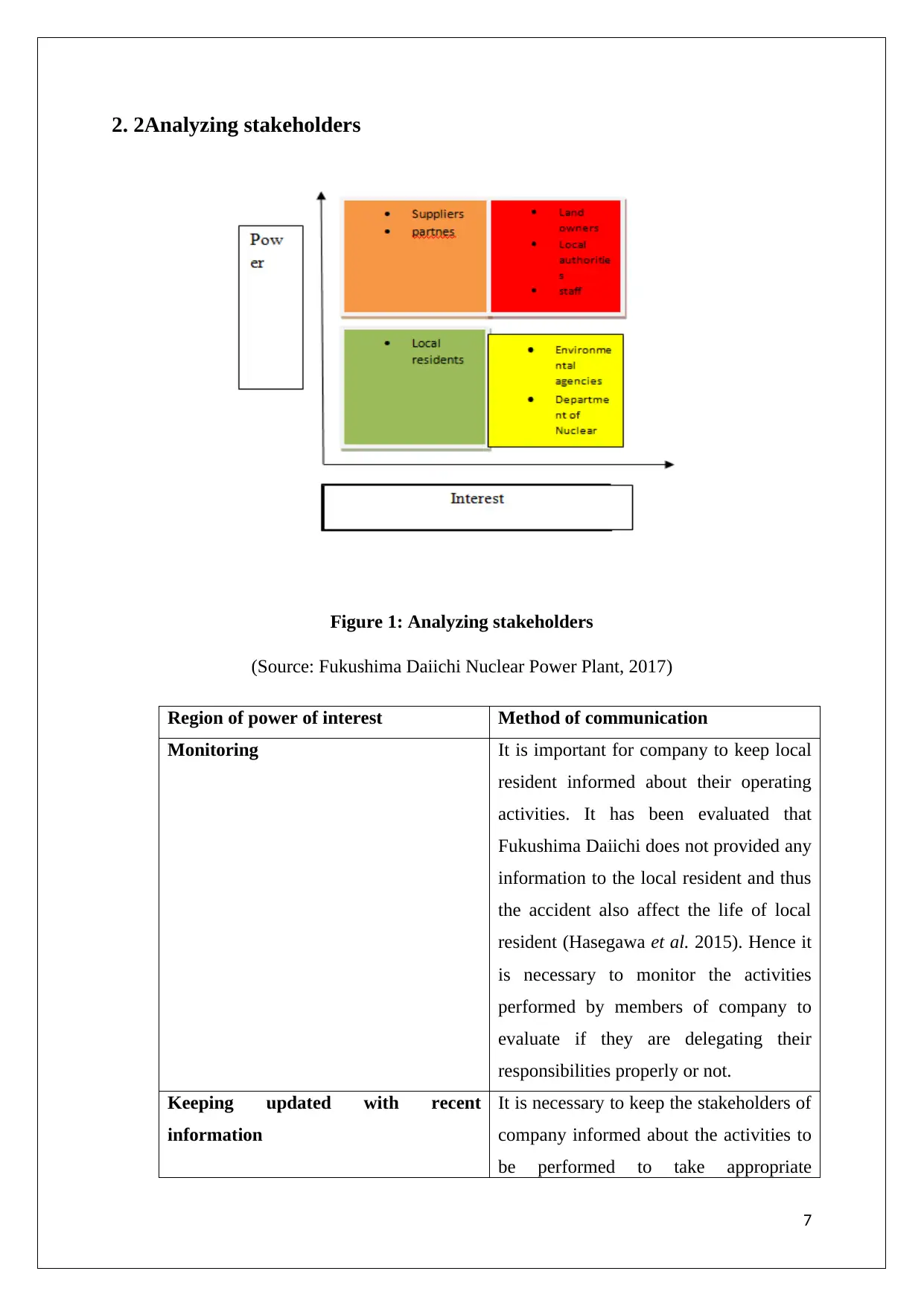
2. 2Analyzing stakeholders
Figure 1: Analyzing stakeholders
(Source: Fukushima Daiichi Nuclear Power Plant, 2017)
Region of power of interest Method of communication
Monitoring It is important for company to keep local
resident informed about their operating
activities. It has been evaluated that
Fukushima Daiichi does not provided any
information to the local resident and thus
the accident also affect the life of local
resident (Hasegawa et al. 2015). Hence it
is necessary to monitor the activities
performed by members of company to
evaluate if they are delegating their
responsibilities properly or not.
Keeping updated with recent
information
It is necessary to keep the stakeholders of
company informed about the activities to
be performed to take appropriate
7
Figure 1: Analyzing stakeholders
(Source: Fukushima Daiichi Nuclear Power Plant, 2017)
Region of power of interest Method of communication
Monitoring It is important for company to keep local
resident informed about their operating
activities. It has been evaluated that
Fukushima Daiichi does not provided any
information to the local resident and thus
the accident also affect the life of local
resident (Hasegawa et al. 2015). Hence it
is necessary to monitor the activities
performed by members of company to
evaluate if they are delegating their
responsibilities properly or not.
Keeping updated with recent
information
It is necessary to keep the stakeholders of
company informed about the activities to
be performed to take appropriate
7
Paraphrase This Document
Need a fresh take? Get an instant paraphrase of this document with our AI Paraphraser
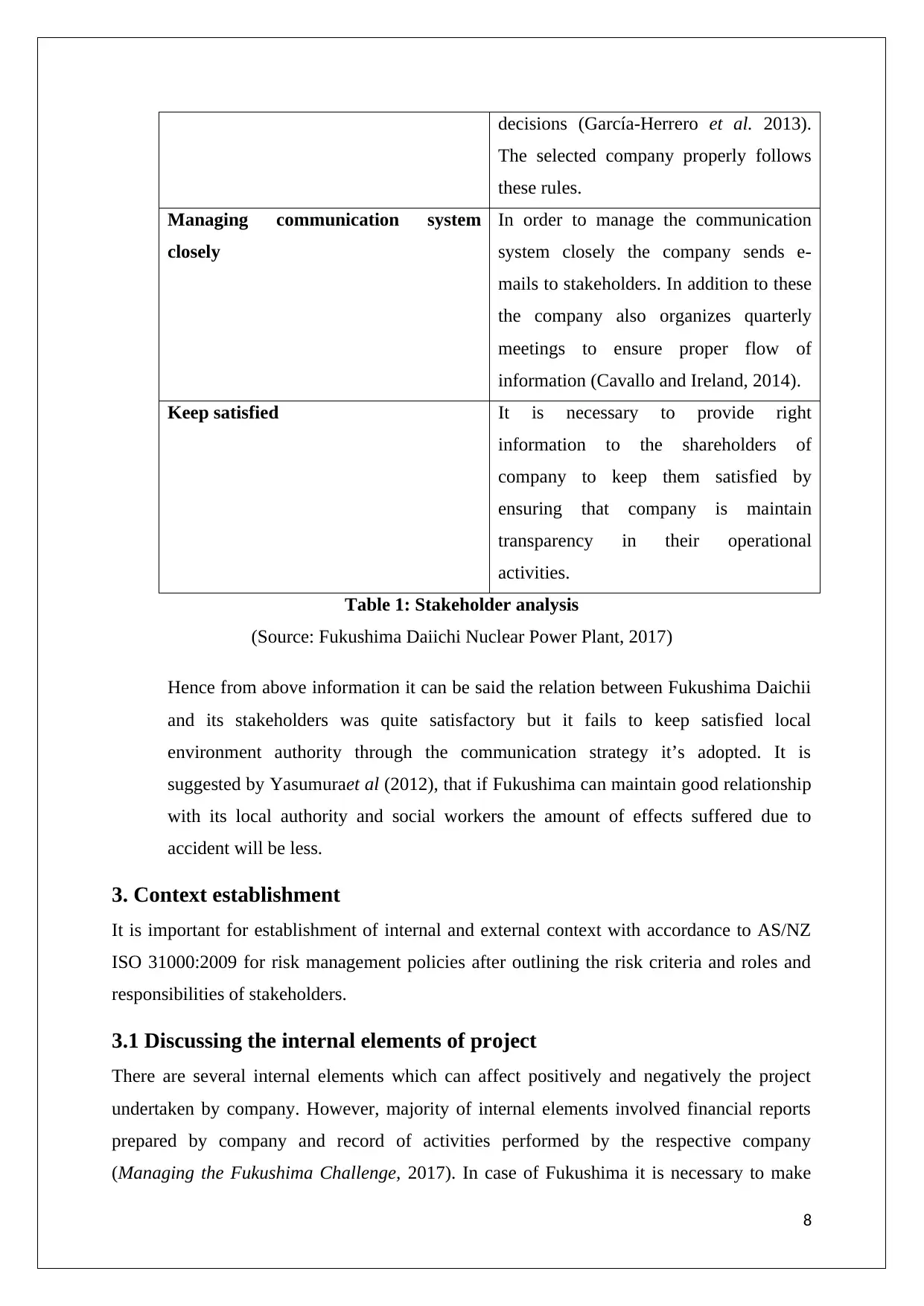
decisions (García-Herrero et al. 2013).
The selected company properly follows
these rules.
Managing communication system
closely
In order to manage the communication
system closely the company sends e-
mails to stakeholders. In addition to these
the company also organizes quarterly
meetings to ensure proper flow of
information (Cavallo and Ireland, 2014).
Keep satisfied It is necessary to provide right
information to the shareholders of
company to keep them satisfied by
ensuring that company is maintain
transparency in their operational
activities.
Table 1: Stakeholder analysis
(Source: Fukushima Daiichi Nuclear Power Plant, 2017)
Hence from above information it can be said the relation between Fukushima Daichii
and its stakeholders was quite satisfactory but it fails to keep satisfied local
environment authority through the communication strategy it’s adopted. It is
suggested by Yasumuraet al (2012), that if Fukushima can maintain good relationship
with its local authority and social workers the amount of effects suffered due to
accident will be less.
3. Context establishment
It is important for establishment of internal and external context with accordance to AS/NZ
ISO 31000:2009 for risk management policies after outlining the risk criteria and roles and
responsibilities of stakeholders.
3.1 Discussing the internal elements of project
There are several internal elements which can affect positively and negatively the project
undertaken by company. However, majority of internal elements involved financial reports
prepared by company and record of activities performed by the respective company
(Managing the Fukushima Challenge, 2017). In case of Fukushima it is necessary to make
8
The selected company properly follows
these rules.
Managing communication system
closely
In order to manage the communication
system closely the company sends e-
mails to stakeholders. In addition to these
the company also organizes quarterly
meetings to ensure proper flow of
information (Cavallo and Ireland, 2014).
Keep satisfied It is necessary to provide right
information to the shareholders of
company to keep them satisfied by
ensuring that company is maintain
transparency in their operational
activities.
Table 1: Stakeholder analysis
(Source: Fukushima Daiichi Nuclear Power Plant, 2017)
Hence from above information it can be said the relation between Fukushima Daichii
and its stakeholders was quite satisfactory but it fails to keep satisfied local
environment authority through the communication strategy it’s adopted. It is
suggested by Yasumuraet al (2012), that if Fukushima can maintain good relationship
with its local authority and social workers the amount of effects suffered due to
accident will be less.
3. Context establishment
It is important for establishment of internal and external context with accordance to AS/NZ
ISO 31000:2009 for risk management policies after outlining the risk criteria and roles and
responsibilities of stakeholders.
3.1 Discussing the internal elements of project
There are several internal elements which can affect positively and negatively the project
undertaken by company. However, majority of internal elements involved financial reports
prepared by company and record of activities performed by the respective company
(Managing the Fukushima Challenge, 2017). In case of Fukushima it is necessary to make
8
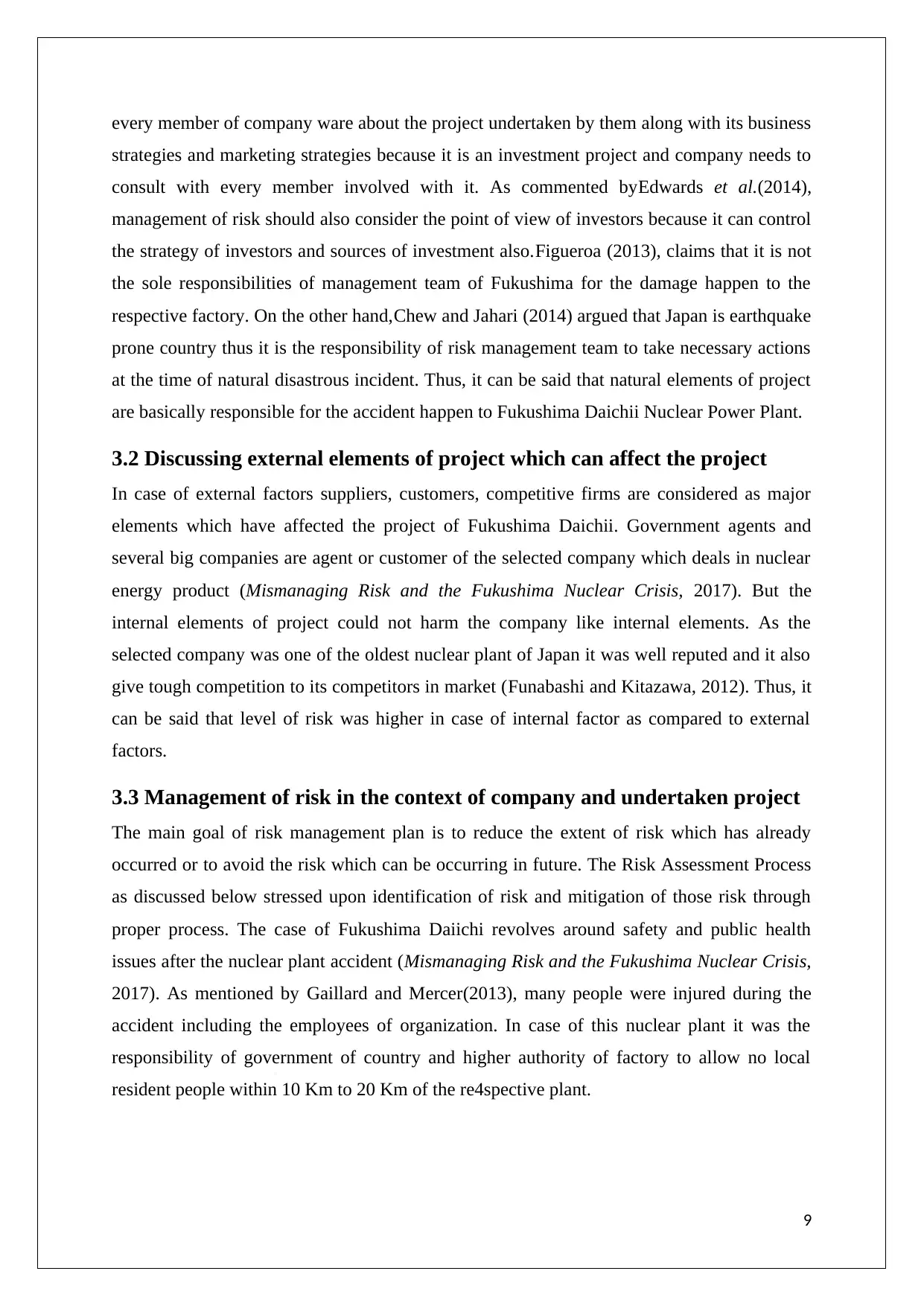
every member of company ware about the project undertaken by them along with its business
strategies and marketing strategies because it is an investment project and company needs to
consult with every member involved with it. As commented byEdwards et al.(2014),
management of risk should also consider the point of view of investors because it can control
the strategy of investors and sources of investment also.Figueroa (2013), claims that it is not
the sole responsibilities of management team of Fukushima for the damage happen to the
respective factory. On the other hand,Chew and Jahari (2014) argued that Japan is earthquake
prone country thus it is the responsibility of risk management team to take necessary actions
at the time of natural disastrous incident. Thus, it can be said that natural elements of project
are basically responsible for the accident happen to Fukushima Daichii Nuclear Power Plant.
3.2 Discussing external elements of project which can affect the project
In case of external factors suppliers, customers, competitive firms are considered as major
elements which have affected the project of Fukushima Daichii. Government agents and
several big companies are agent or customer of the selected company which deals in nuclear
energy product (Mismanaging Risk and the Fukushima Nuclear Crisis, 2017). But the
internal elements of project could not harm the company like internal elements. As the
selected company was one of the oldest nuclear plant of Japan it was well reputed and it also
give tough competition to its competitors in market (Funabashi and Kitazawa, 2012). Thus, it
can be said that level of risk was higher in case of internal factor as compared to external
factors.
3.3 Management of risk in the context of company and undertaken project
The main goal of risk management plan is to reduce the extent of risk which has already
occurred or to avoid the risk which can be occurring in future. The Risk Assessment Process
as discussed below stressed upon identification of risk and mitigation of those risk through
proper process. The case of Fukushima Daiichi revolves around safety and public health
issues after the nuclear plant accident (Mismanaging Risk and the Fukushima Nuclear Crisis,
2017). As mentioned by Gaillard and Mercer(2013), many people were injured during the
accident including the employees of organization. In case of this nuclear plant it was the
responsibility of government of country and higher authority of factory to allow no local
resident people within 10 Km to 20 Km of the re4spective plant.
9
strategies and marketing strategies because it is an investment project and company needs to
consult with every member involved with it. As commented byEdwards et al.(2014),
management of risk should also consider the point of view of investors because it can control
the strategy of investors and sources of investment also.Figueroa (2013), claims that it is not
the sole responsibilities of management team of Fukushima for the damage happen to the
respective factory. On the other hand,Chew and Jahari (2014) argued that Japan is earthquake
prone country thus it is the responsibility of risk management team to take necessary actions
at the time of natural disastrous incident. Thus, it can be said that natural elements of project
are basically responsible for the accident happen to Fukushima Daichii Nuclear Power Plant.
3.2 Discussing external elements of project which can affect the project
In case of external factors suppliers, customers, competitive firms are considered as major
elements which have affected the project of Fukushima Daichii. Government agents and
several big companies are agent or customer of the selected company which deals in nuclear
energy product (Mismanaging Risk and the Fukushima Nuclear Crisis, 2017). But the
internal elements of project could not harm the company like internal elements. As the
selected company was one of the oldest nuclear plant of Japan it was well reputed and it also
give tough competition to its competitors in market (Funabashi and Kitazawa, 2012). Thus, it
can be said that level of risk was higher in case of internal factor as compared to external
factors.
3.3 Management of risk in the context of company and undertaken project
The main goal of risk management plan is to reduce the extent of risk which has already
occurred or to avoid the risk which can be occurring in future. The Risk Assessment Process
as discussed below stressed upon identification of risk and mitigation of those risk through
proper process. The case of Fukushima Daiichi revolves around safety and public health
issues after the nuclear plant accident (Mismanaging Risk and the Fukushima Nuclear Crisis,
2017). As mentioned by Gaillard and Mercer(2013), many people were injured during the
accident including the employees of organization. In case of this nuclear plant it was the
responsibility of government of country and higher authority of factory to allow no local
resident people within 10 Km to 20 Km of the re4spective plant.
9
⊘ This is a preview!⊘
Do you want full access?
Subscribe today to unlock all pages.

Trusted by 1+ million students worldwide
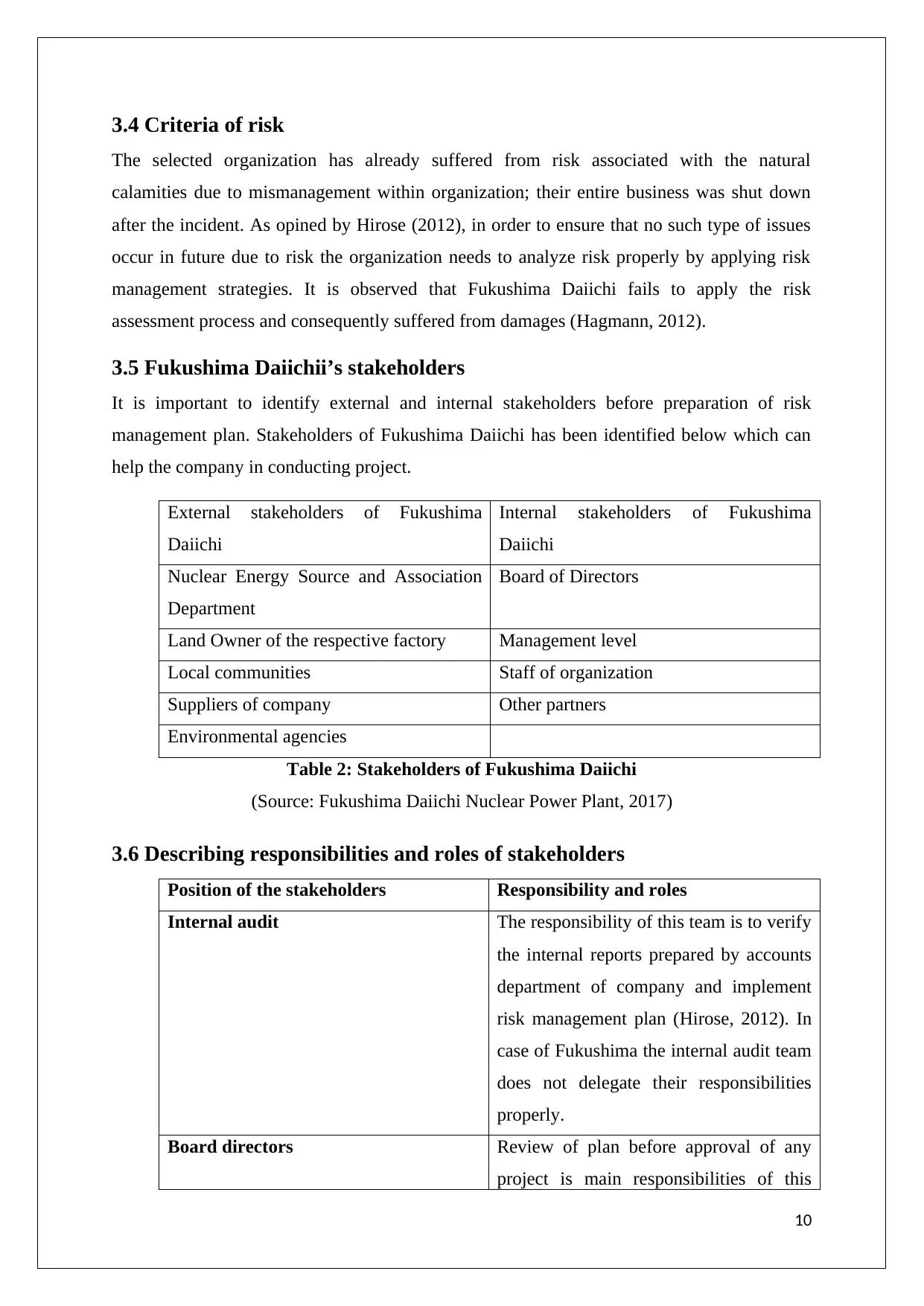
3.4 Criteria of risk
The selected organization has already suffered from risk associated with the natural
calamities due to mismanagement within organization; their entire business was shut down
after the incident. As opined by Hirose (2012), in order to ensure that no such type of issues
occur in future due to risk the organization needs to analyze risk properly by applying risk
management strategies. It is observed that Fukushima Daiichi fails to apply the risk
assessment process and consequently suffered from damages (Hagmann, 2012).
3.5 Fukushima Daiichii’s stakeholders
It is important to identify external and internal stakeholders before preparation of risk
management plan. Stakeholders of Fukushima Daiichi has been identified below which can
help the company in conducting project.
External stakeholders of Fukushima
Daiichi
Internal stakeholders of Fukushima
Daiichi
Nuclear Energy Source and Association
Department
Board of Directors
Land Owner of the respective factory Management level
Local communities Staff of organization
Suppliers of company Other partners
Environmental agencies
Table 2: Stakeholders of Fukushima Daiichi
(Source: Fukushima Daiichi Nuclear Power Plant, 2017)
3.6 Describing responsibilities and roles of stakeholders
Position of the stakeholders Responsibility and roles
Internal audit The responsibility of this team is to verify
the internal reports prepared by accounts
department of company and implement
risk management plan (Hirose, 2012). In
case of Fukushima the internal audit team
does not delegate their responsibilities
properly.
Board directors Review of plan before approval of any
project is main responsibilities of this
10
The selected organization has already suffered from risk associated with the natural
calamities due to mismanagement within organization; their entire business was shut down
after the incident. As opined by Hirose (2012), in order to ensure that no such type of issues
occur in future due to risk the organization needs to analyze risk properly by applying risk
management strategies. It is observed that Fukushima Daiichi fails to apply the risk
assessment process and consequently suffered from damages (Hagmann, 2012).
3.5 Fukushima Daiichii’s stakeholders
It is important to identify external and internal stakeholders before preparation of risk
management plan. Stakeholders of Fukushima Daiichi has been identified below which can
help the company in conducting project.
External stakeholders of Fukushima
Daiichi
Internal stakeholders of Fukushima
Daiichi
Nuclear Energy Source and Association
Department
Board of Directors
Land Owner of the respective factory Management level
Local communities Staff of organization
Suppliers of company Other partners
Environmental agencies
Table 2: Stakeholders of Fukushima Daiichi
(Source: Fukushima Daiichi Nuclear Power Plant, 2017)
3.6 Describing responsibilities and roles of stakeholders
Position of the stakeholders Responsibility and roles
Internal audit The responsibility of this team is to verify
the internal reports prepared by accounts
department of company and implement
risk management plan (Hirose, 2012). In
case of Fukushima the internal audit team
does not delegate their responsibilities
properly.
Board directors Review of plan before approval of any
project is main responsibilities of this
10
Paraphrase This Document
Need a fresh take? Get an instant paraphrase of this document with our AI Paraphraser
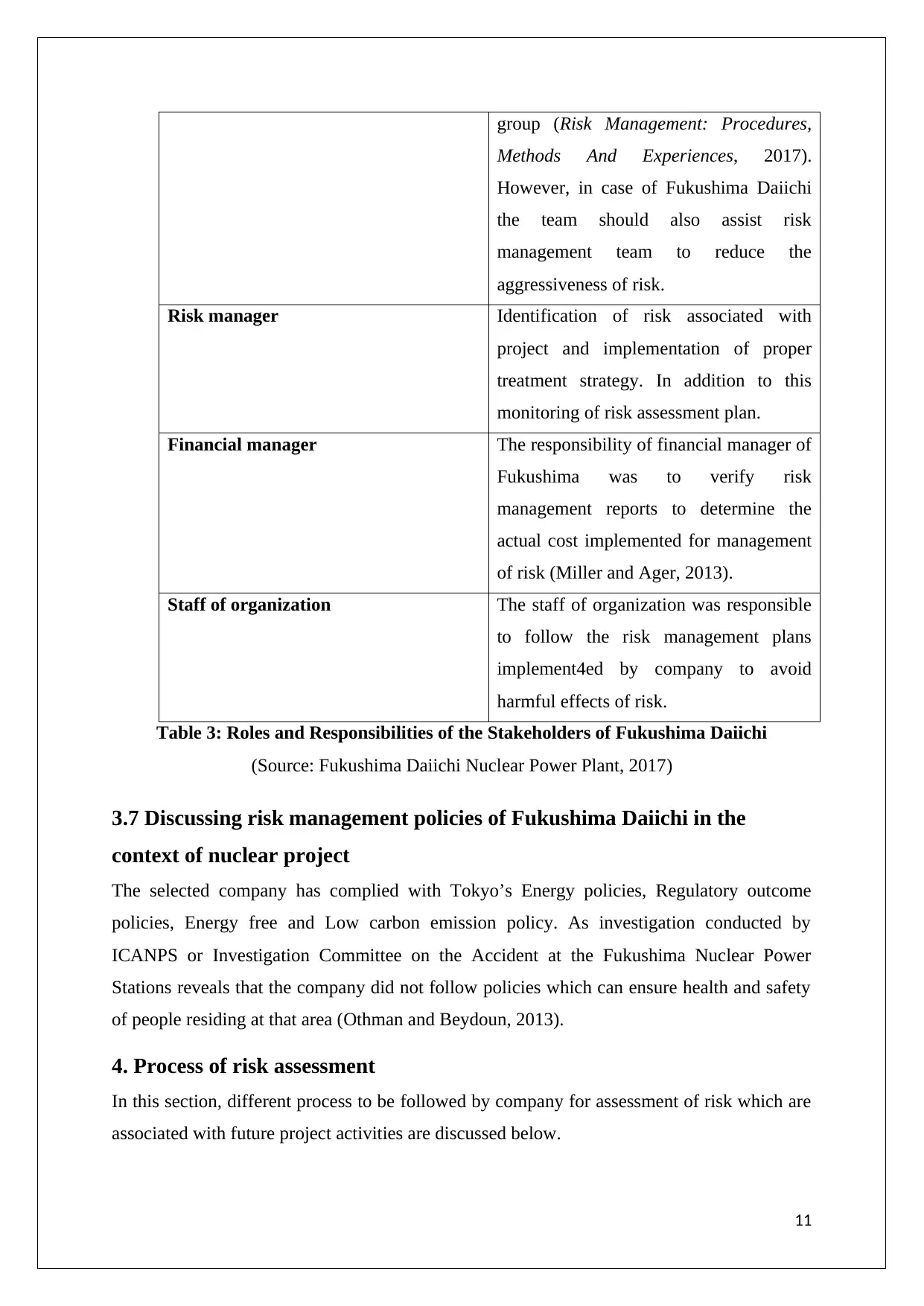
group (Risk Management: Procedures,
Methods And Experiences, 2017).
However, in case of Fukushima Daiichi
the team should also assist risk
management team to reduce the
aggressiveness of risk.
Risk manager Identification of risk associated with
project and implementation of proper
treatment strategy. In addition to this
monitoring of risk assessment plan.
Financial manager The responsibility of financial manager of
Fukushima was to verify risk
management reports to determine the
actual cost implemented for management
of risk (Miller and Ager, 2013).
Staff of organization The staff of organization was responsible
to follow the risk management plans
implement4ed by company to avoid
harmful effects of risk.
Table 3: Roles and Responsibilities of the Stakeholders of Fukushima Daiichi
(Source: Fukushima Daiichi Nuclear Power Plant, 2017)
3.7 Discussing risk management policies of Fukushima Daiichi in the
context of nuclear project
The selected company has complied with Tokyo’s Energy policies, Regulatory outcome
policies, Energy free and Low carbon emission policy. As investigation conducted by
ICANPS or Investigation Committee on the Accident at the Fukushima Nuclear Power
Stations reveals that the company did not follow policies which can ensure health and safety
of people residing at that area (Othman and Beydoun, 2013).
4. Process of risk assessment
In this section, different process to be followed by company for assessment of risk which are
associated with future project activities are discussed below.
11
Methods And Experiences, 2017).
However, in case of Fukushima Daiichi
the team should also assist risk
management team to reduce the
aggressiveness of risk.
Risk manager Identification of risk associated with
project and implementation of proper
treatment strategy. In addition to this
monitoring of risk assessment plan.
Financial manager The responsibility of financial manager of
Fukushima was to verify risk
management reports to determine the
actual cost implemented for management
of risk (Miller and Ager, 2013).
Staff of organization The staff of organization was responsible
to follow the risk management plans
implement4ed by company to avoid
harmful effects of risk.
Table 3: Roles and Responsibilities of the Stakeholders of Fukushima Daiichi
(Source: Fukushima Daiichi Nuclear Power Plant, 2017)
3.7 Discussing risk management policies of Fukushima Daiichi in the
context of nuclear project
The selected company has complied with Tokyo’s Energy policies, Regulatory outcome
policies, Energy free and Low carbon emission policy. As investigation conducted by
ICANPS or Investigation Committee on the Accident at the Fukushima Nuclear Power
Stations reveals that the company did not follow policies which can ensure health and safety
of people residing at that area (Othman and Beydoun, 2013).
4. Process of risk assessment
In this section, different process to be followed by company for assessment of risk which are
associated with future project activities are discussed below.
11
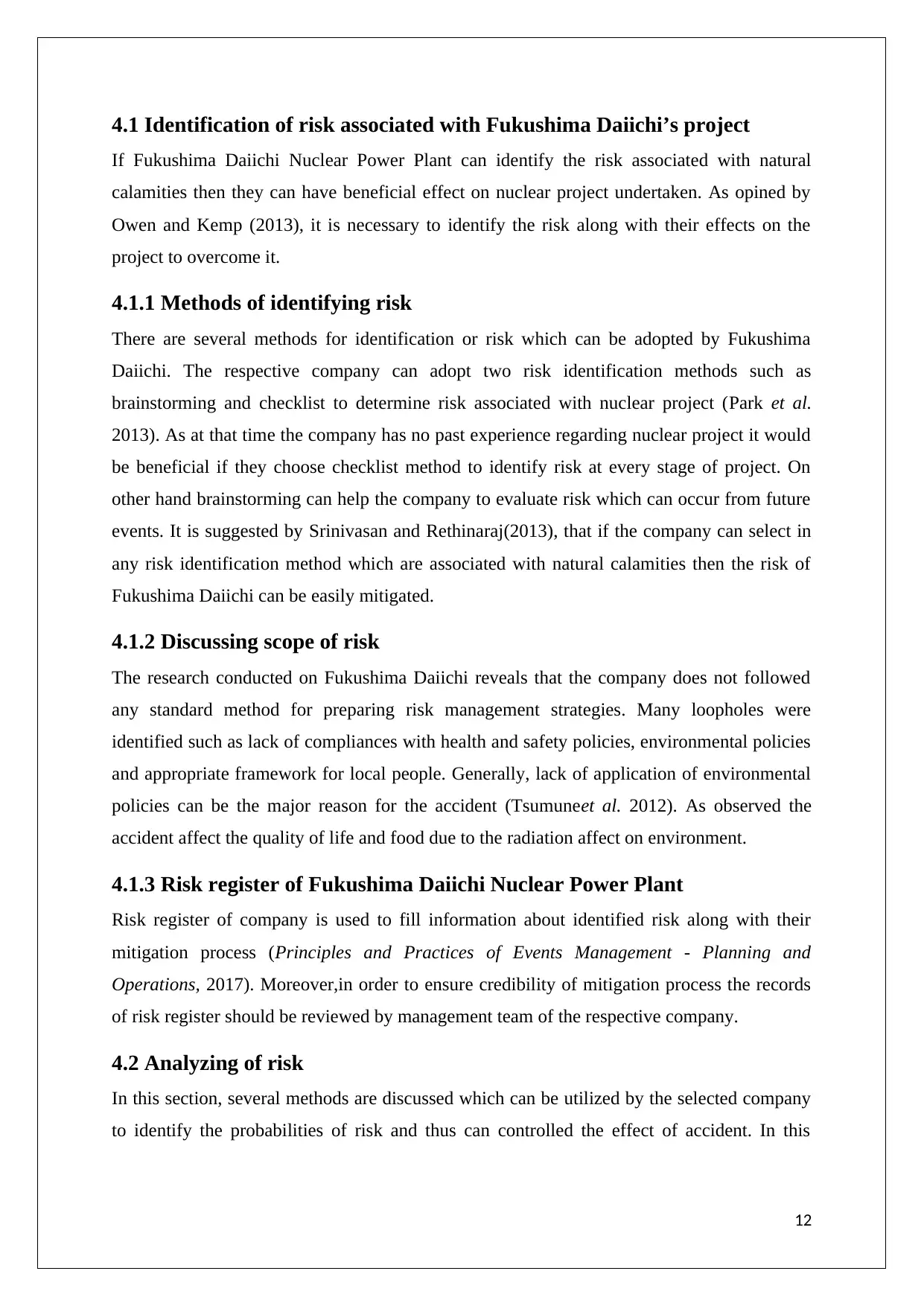
4.1 Identification of risk associated with Fukushima Daiichi’s project
If Fukushima Daiichi Nuclear Power Plant can identify the risk associated with natural
calamities then they can have beneficial effect on nuclear project undertaken. As opined by
Owen and Kemp (2013), it is necessary to identify the risk along with their effects on the
project to overcome it.
4.1.1 Methods of identifying risk
There are several methods for identification or risk which can be adopted by Fukushima
Daiichi. The respective company can adopt two risk identification methods such as
brainstorming and checklist to determine risk associated with nuclear project (Park et al.
2013). As at that time the company has no past experience regarding nuclear project it would
be beneficial if they choose checklist method to identify risk at every stage of project. On
other hand brainstorming can help the company to evaluate risk which can occur from future
events. It is suggested by Srinivasan and Rethinaraj(2013), that if the company can select in
any risk identification method which are associated with natural calamities then the risk of
Fukushima Daiichi can be easily mitigated.
4.1.2 Discussing scope of risk
The research conducted on Fukushima Daiichi reveals that the company does not followed
any standard method for preparing risk management strategies. Many loopholes were
identified such as lack of compliances with health and safety policies, environmental policies
and appropriate framework for local people. Generally, lack of application of environmental
policies can be the major reason for the accident (Tsumuneet al. 2012). As observed the
accident affect the quality of life and food due to the radiation affect on environment.
4.1.3 Risk register of Fukushima Daiichi Nuclear Power Plant
Risk register of company is used to fill information about identified risk along with their
mitigation process (Principles and Practices of Events Management - Planning and
Operations, 2017). Moreover,in order to ensure credibility of mitigation process the records
of risk register should be reviewed by management team of the respective company.
4.2 Analyzing of risk
In this section, several methods are discussed which can be utilized by the selected company
to identify the probabilities of risk and thus can controlled the effect of accident. In this
12
If Fukushima Daiichi Nuclear Power Plant can identify the risk associated with natural
calamities then they can have beneficial effect on nuclear project undertaken. As opined by
Owen and Kemp (2013), it is necessary to identify the risk along with their effects on the
project to overcome it.
4.1.1 Methods of identifying risk
There are several methods for identification or risk which can be adopted by Fukushima
Daiichi. The respective company can adopt two risk identification methods such as
brainstorming and checklist to determine risk associated with nuclear project (Park et al.
2013). As at that time the company has no past experience regarding nuclear project it would
be beneficial if they choose checklist method to identify risk at every stage of project. On
other hand brainstorming can help the company to evaluate risk which can occur from future
events. It is suggested by Srinivasan and Rethinaraj(2013), that if the company can select in
any risk identification method which are associated with natural calamities then the risk of
Fukushima Daiichi can be easily mitigated.
4.1.2 Discussing scope of risk
The research conducted on Fukushima Daiichi reveals that the company does not followed
any standard method for preparing risk management strategies. Many loopholes were
identified such as lack of compliances with health and safety policies, environmental policies
and appropriate framework for local people. Generally, lack of application of environmental
policies can be the major reason for the accident (Tsumuneet al. 2012). As observed the
accident affect the quality of life and food due to the radiation affect on environment.
4.1.3 Risk register of Fukushima Daiichi Nuclear Power Plant
Risk register of company is used to fill information about identified risk along with their
mitigation process (Principles and Practices of Events Management - Planning and
Operations, 2017). Moreover,in order to ensure credibility of mitigation process the records
of risk register should be reviewed by management team of the respective company.
4.2 Analyzing of risk
In this section, several methods are discussed which can be utilized by the selected company
to identify the probabilities of risk and thus can controlled the effect of accident. In this
12
⊘ This is a preview!⊘
Do you want full access?
Subscribe today to unlock all pages.

Trusted by 1+ million students worldwide
1 out of 32
Related Documents
Your All-in-One AI-Powered Toolkit for Academic Success.
+13062052269
info@desklib.com
Available 24*7 on WhatsApp / Email
![[object Object]](/_next/static/media/star-bottom.7253800d.svg)
Unlock your academic potential
Copyright © 2020–2025 A2Z Services. All Rights Reserved. Developed and managed by ZUCOL.





